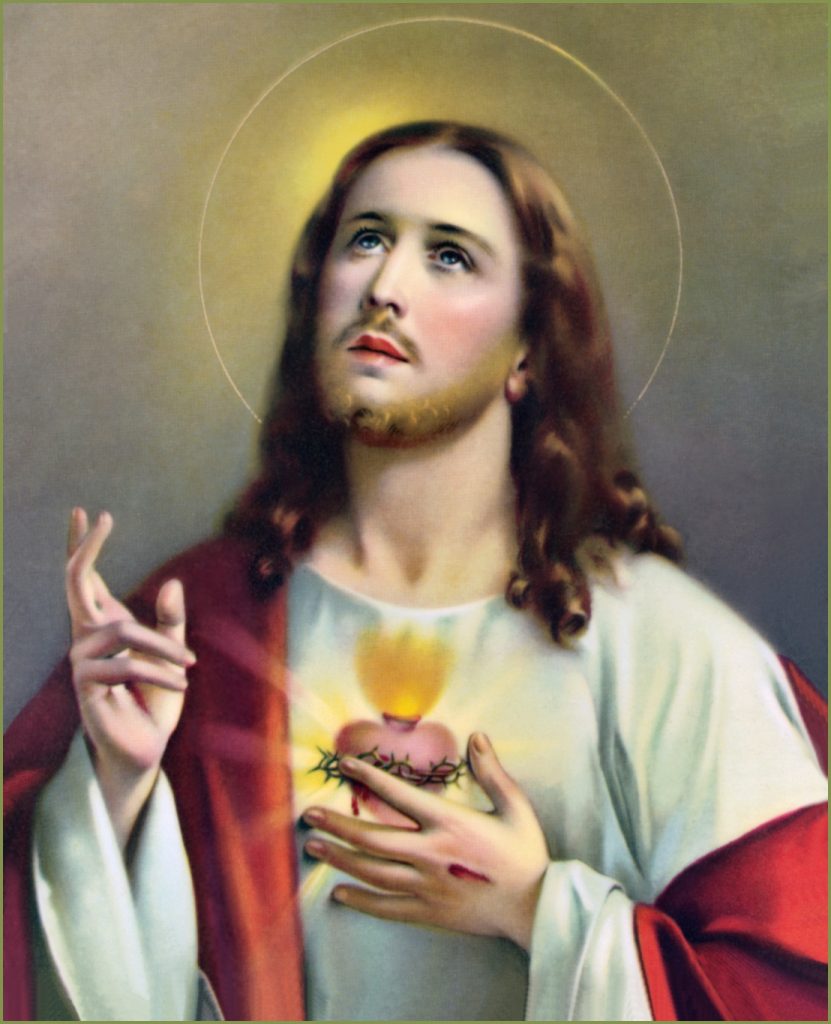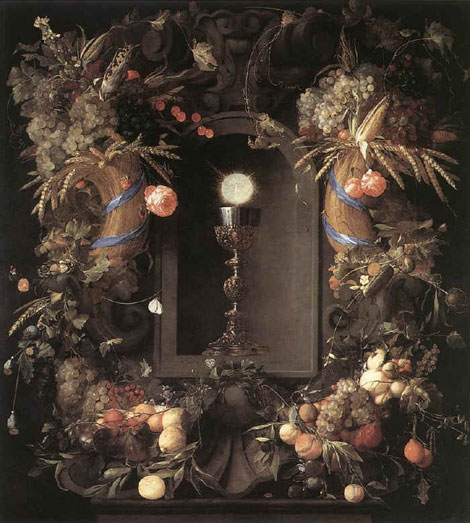Faith
Feast of the Most Sacred Heart of Jesus – Friday, June 16
Friday after the Octave of Corpus Christi
Double of the First Class – White Vestments
Why do we adore and worship the Heart of Our Lord?

Prostestantism in the sixteenth century and Jansenism in the seventeenth had attempted to distort one of the essential truths of Christianity, namely the love of God for all men.
It became necessary that the Spirit of love, which directs the Church, should by some new means counteract the spreading heresy, in order that the Spouse of Christ, far from seeing her love for Jesus diminish should feel it always increasing.
This was made manifest in Catholic worship, which is the sure rule of our faith, by the institution of the Feast of the Sacred Heart.
Already in the Middle-Ages, many Fathers and Doctors, v. g. St. Bonaventure, and the two Benedictine virgins, St. Gertrude and St. Mechtilde, had a clear vision of the devotion to the Sacred Heart.
But in order to make this worship public and recognized, Providence first raised up St. John Eudes, who in 1670 composed an Office and a Mass of the Sacred Heart for the so-called Congregation of the Eudists. Providence then chose one of the spiritual daughters of St. Francis de Sales, St. Margaret Mary Alocoque, to whom Jesus showed His Heart at Paray-le-Monial, on June 16, 1675, Sunday after Corpus Christi, and asked her to institute a feast of the Sacred Heart on the Friday following the Octave of Corpus Christi, and asked her to institute a feast of the Sacred Heart on the Friday following the Octave of Corpus Christi. Lastly, God employed Blessed Claude de la Colombiere and the Society of Jesus for the propagation of this devotion.
In 1765, Clement XIII gave his approbation to the feast and the Office of the Sacred Heart, and in 1856 Pius IX extended it to the universal Church. In 1929 Pius XI composed a new Mass and Office for this feast and gave it a privileged Octave of the third Order.
The solemnity of the Sacred Heart recapitulates all the phases of the life of Jesus recalled in the liturgy from Advent to the Feast of Corpus Christi.
Its object is materially Jesus’ Heart of flesh, and formally the unbounded charity symbolized by this Heart, and manifested by all the mysteries of the Savior’s life, but especially by His incarnation, His death on Calvary, and the institution of the Holy Eucharist. It celebrates all the favors we have received from divine charity during the year (Collect), all His mercies (Tract), and all the marvelous things that Jesus has done for us (Introit, Alleluia).
As these manifestations of Christ’s love show the more the ingratitude of men, who only answer by coldness and indifference (Offertory), this solemnity has also a character of reparation (Collect).
It is out of love for us that Christ made Himself the victim of His sacrifice, He is thereby our Redeemer, our King of Love by right of conquest.
This Sunday is the External Solemnity of the Most Sacred Heart of Jesus.
Feast of Corpus Christi
“My flesh is meat indeed, and My Blood is drink indeed. He that eateth my flesh and drinketh my blood, abides in me, and I in him. As the living Father hath sent me, and I live by the Father, so he that eateth Me, the same also shall live by me. This is that bread that down from Heaven. Not as your fathers did eat manna and are dead. He that eateth of this Bread shall live forever.“
-John 6:56-59-

Ten times in John’s gospel, Christ insists that we eat His Flesh and drink His Blood. And He let people walk away when they took Him literally. They said, “That’s too much for us. We’re not having any of that.” And they left, and He let them leave. We have many places in the Gospels where if there is a misunderstanding, Christ corrects that misunderstanding. There was no ambiguity when Christ said that we must eat His flesh and drink His Blood. He knew what He was saying, and He meant what He said, and He allowed those who did not believe Him to walk away.
To resist the attacks of continually renewed heresies against the Holy Eucharist and to revive in the Church a fervor which had somewhat grown cold, the Holy Ghost inspired, at the beginning of the thirteenth century, the solemnity of Corpus Christi
In 1208 blessed Juliana of Mount Cornillon, near Liege, saw in a vision the full moon with an indentation indicating that a feast was missing in the liturgical cycle. The Eucharist instituted on Maundy Thursday, could not be celebrated with all the desired pomp, the Church’s thoughts being absorbed by the passion of the Savior. It was necessary and immediately after Paschaltide a feast with an octave should be established. And as the Last Supper had taken place on a Thursday, the Bishop of Liege instituted in 1246 this solemnity in his diocese on the first free Thursday after the octave of Pentecost. In 1264, Pope Urban IV extended this feast to the whole world.
The Eucharist instituted on the eve of Jesus’ death, remains the memorial of His passion (Collect). The altar is the continuation of Calvary, “the Mass announces the death of the Lord” (Epistle). Jesus is there as a victim, for the words of the double consecration tell us that it is the bread which is first changed into the Body of Christ, and then the wine into His blood: under these appearances, Jesus Himself offers to His Father, at the same time as His priests, the Blood which He shed and His Body which was nailed to the Cross.
One takes part in the sacrifice by eating of the victim: Eucharist was instituted in the form of food (Alleluia) so that we may receive in Communion the victim of Calvary. The Sacred Host has become wheat which nourishes our souls” (Introit).
The Mass is the center of the whole Eucharistic worship of the Church, and Holy Communion is the means instituted by Jesus to enable us to participate more fully in this divine sacrifice.